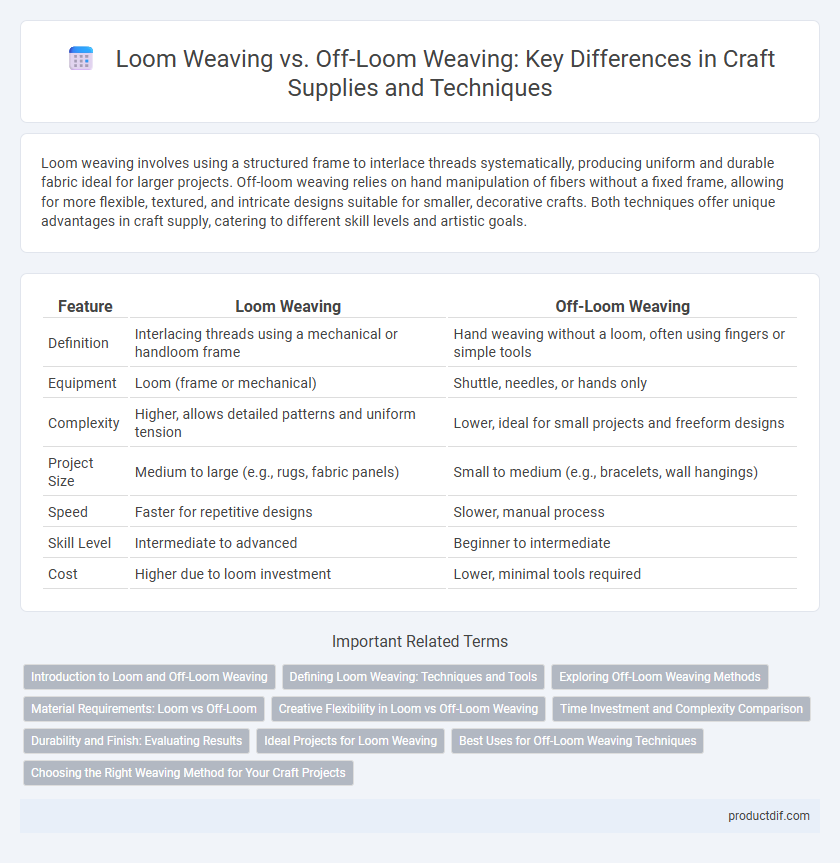Loom weaving involves using a structured frame to interlace threads systematically, producing uniform and durable fabric ideal for larger projects. Off-loom weaving relies on hand manipulation of fibers without a fixed frame, allowing for more flexible, textured, and intricate designs suitable for smaller, decorative crafts. Both techniques offer unique advantages in craft supply, catering to different skill levels and artistic goals.
Table of Comparison
| Feature | Loom Weaving | Off-Loom Weaving |
|---|---|---|
| Definition | Interlacing threads using a mechanical or handloom frame | Hand weaving without a loom, often using fingers or simple tools |
| Equipment | Loom (frame or mechanical) | Shuttle, needles, or hands only |
| Complexity | Higher, allows detailed patterns and uniform tension | Lower, ideal for small projects and freeform designs |
| Project Size | Medium to large (e.g., rugs, fabric panels) | Small to medium (e.g., bracelets, wall hangings) |
| Speed | Faster for repetitive designs | Slower, manual process |
| Skill Level | Intermediate to advanced | Beginner to intermediate |
| Cost | Higher due to loom investment | Lower, minimal tools required |
Introduction to Loom and Off-Loom Weaving
Loom weaving utilizes a structured frame that holds warp threads taut, enabling precise and consistent interlacing with weft threads to create durable textiles. Off-loom weaving, such as finger weaving or tablet weaving, operates without a traditional loom, relying on manual techniques to manipulate threads directly, offering greater flexibility and portability. Both methods serve distinct crafting needs, with loom weaving suited for larger, uniform fabrics and off-loom weaving ideal for intricate, portable projects.
Defining Loom Weaving: Techniques and Tools
Loom weaving involves using a frame or machine, known as a loom, to interlace warp and weft threads in a structured, grid-like pattern, creating sturdy and uniform fabrics ideal for detailed textile projects. Techniques such as plain weave, twill, and satin weave are executed using tools like heddles, shuttles, and beaters, which help maintain tension and alignment of threads. This method contrasts with off-loom weaving by offering greater precision and the ability to produce larger, more consistent textiles, favored in craft supply for producing high-quality woven goods.
Exploring Off-Loom Weaving Methods
Off-loom weaving methods, such as finger weaving, tablet weaving, and kumihimo braiding, offer versatile techniques that do not require a traditional loom, allowing for portable and flexible craft projects. These techniques emphasize creating intricate patterns and textures through hand manipulation of threads, appealing to crafters seeking diverse textile designs beyond rigid loom constraints. Off-loom weaving supports experimentation with various fibers like cotton, silk, and synthetic yarns, expanding creative possibilities in handmade accessories and decorative pieces.
Material Requirements: Loom vs Off-Loom
Loom weaving requires a sturdy frame, warp threads tightly stretched, and often involves wooden or metal materials to maintain tension and structure. Off-loom weaving uses flexible bases such as cardboard, mesh, or even natural fibers, allowing greater versatility with materials but less structural rigidity. Materials for off-loom techniques often include yarn, ribbons, or strips of fabric, contrasting with the more constrained setup needed for traditional loom weaving.
Creative Flexibility in Loom vs Off-Loom Weaving
Loom weaving offers structured patterns and consistent tension, enabling more intricate and uniform textile designs, ideal for projects requiring precise detail and durability. Off-loom weaving provides greater creative flexibility, allowing artisans to experiment with unconventional shapes, textures, and mixed materials without the constraints of a fixed frame. This adaptability makes off-loom techniques perfect for innovative, sculptural crafts and personalized textile art.
Time Investment and Complexity Comparison
Loom weaving requires a significant time investment due to the setup of the loom and precise thread alignment, which adds to the complexity of the process compared to off-loom weaving techniques such as finger weaving or twining. Off-loom weaving offers greater flexibility and typically involves simpler tools, reducing both the skill level needed and the overall time commitment. Craft enthusiasts often choose off-loom methods for quicker, less complex projects, while loom weaving is favored for detailed, larger-scale textile creations demanding intricate patterns and durability.
Durability and Finish: Evaluating Results
Loom weaving produces highly durable fabrics with tight, consistent tension that enhances structural integrity and longevity, ideal for complex patterns and robust finishes. Off-loom weaving, while more flexible for unique textures and experimental designs, often results in looser weaves that may lack the same durability and polished finish as loom-woven textiles. Evaluating the final product's use and aesthetic preference is crucial when choosing between loom and off-loom weaving techniques for craft projects.
Ideal Projects for Loom Weaving
Loom weaving excels in creating detailed, uniform patterns ideal for projects like tapestries, scarves, and intricate fabric panels. The controlled tension and precise weaving process support complex designs, making it perfect for textile art and structured garments. This method ensures durability and consistency, advantageous for producing high-quality, professional-level craft supplies.
Best Uses for Off-Loom Weaving Techniques
Off-loom weaving techniques excel in creating intricate patterns and three-dimensional textures ideal for small-scale projects like jewelry, tapestries, and decorative accessories. These methods offer greater versatility and portability compared to loom weaving, making them perfect for detailed craftwork, experimental designs, and quick prototyping. Off-loom weaving is especially suitable for fiber artists seeking flexibility in structure and materials without the constraints of a traditional loom frame.
Choosing the Right Weaving Method for Your Craft Projects
Loom weaving offers precise tension control and uniform patterns, making it ideal for complex or large-scale craft projects requiring consistency and durability. Off-loom weaving provides flexibility and portability, perfect for smaller, experimental, or mixed-media crafts where intricate hand manipulation and unique textures are desired. Assess project size, material type, and desired finish to determine whether the structured efficiency of loom weaving or the creative freedom of off-loom weaving best suits your crafting needs.
Loom weaving vs Off-loom weaving Infographic

 productdif.com
productdif.com